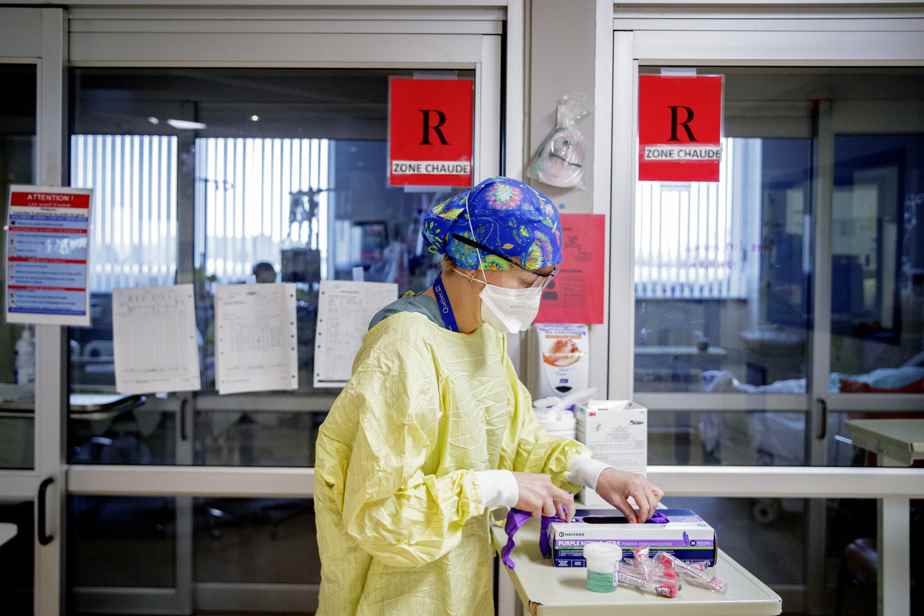Many more deaths, higher hospitalizations, but above all, strong community transmission: 2022 is to date the worst pandemic summer that Quebec has experienced. In the midst of the seventh wave, the province is now facing a new reality: the new variants are increasingly breaking the “seasonal logic” to which COVID-19 has so far accustomed us.
Posted at 6:30 p.m.
“The more the virus changes, the more it surprises us. It is increasingly undoing the phenomenon of seasonal cycles that we saw before, a bit like the flu. It’s something that we had started to see with the previous variants, but which is more and more pronounced”, explains the DD Sophie Zhang, family doctor at CHSLD Bruchési.
The pandemic is much more felt in Quebec hospitals this summer. They must currently deal with 1887 infected patients. This is significantly more than the last two years, even taking into account the fact that only a third of people hospitalized (or 640) were admitted due to COVID-19. During the same period in 2020, there were 285 infected patients and 81 in 2021.

On the mortality side, Quebec reports an average of 11 deaths per day. At this time in 2020, it was less than 3 per day. Moreover, the comparison with the summer of 2021 is even more striking. Between June 15 and August 31, Quebec had deplored a total of 54 deaths. This summer, Quebec has already reported 243 since mid-June.

The virus “has not finished changing”
The DD Zhang recalls that the virus is increasingly “thwarting” the immune efficacy of vaccines, which makes the potential for contamination even greater, especially as the vaccination campaign for the booster dose is running out of steam in Quebec. “It’s a surprise effect. We’ve gone to several waves, we’ve gone a little [mieux] prepared. No one suddenly expected to have so many cases this summer,” she adds.
As in previous waves, young people are spreading the coronavirus while older people are paying the price. Two-thirds of people currently infected are under 60 years old. These are doing quite well, with few of them experiencing complications. Conversely, seniors aged 80 and over largely explain the heavy toll of COVID-19 this summer. If they record barely 13% of cases, they represent more than a third of hospitalizations and two thirds of deaths.

“The problem, for me, is that we act a little as if we were really in an endemic phase, when we are not. We are not yet able to control the virus, we cannot predict it, it is not cyclical like influenza, for example. This is what surprises us all at the moment, ”says virologist and professor in the department of biological sciences at UQAM Benoit Barbeau, for whom the growing vaccine escape is probably also “for a lot”.
In his eyes, the population “has already decided that the pandemic was endemic, and that we are moving on”, which he says he understands after more than a year of health restrictions. “Except that the reality is that we will not be endemic until we are able to predict the spread of this virus. »
We are in the idea that we are living with COVID-19, but it still surprises us enormously.
Benoit Barbeau, virologist
“We see that since the BA.5 variant, in particular, the virus has really improved its ability to transmit, he adds. And it is to be expected for the next few months that it will continue to do so. He is not done changing. »
Absences “hurt”
If deaths and hospitalizations remain under control in the health network, it is above all the strong community transmission and the marked absence of staff that currently “hurt”, estimates the president of the Association of specialists in medicine. emergency of Quebec, the Dr Gilbert Boucher. On Friday, there were 7,138 workers absent due to the pandemic in the health network.
“The biggest problem we have at the moment is really the congestion of the system, he observes. When we add two or three colleagues who disappear every shift because of COVID, that gives days on floors where there are almost no admissions. »
The Dr Boucher affirms that from the start of the day, in several establishments, “the emergency rooms are already half-filled with patients who are awaiting hospitalizations” for COVID-19, but especially for the majority for other reasons. “Dealing with 10,000 patients with half the beds that can be managed is very complex. For three months, the rate of departure of patients who leave without having seen a doctor has been around 15%. Historically, we are more on 10%, ”he continues.
The situation in brief
The 11 deaths reported on Friday brought the daily average calculated over seven days to 11. The trend is up 10% over one week. Quebec also reported an increase of 27 hospitalizations on Friday. The 1,887 people currently hospitalized represent an increase of 22% over one week. In intensive care, the 42 patients represent a stable trend over one week. The 1,910 new cases reported on Friday brought the daily average to 1,736. The trend is thus up 26% over one week. Finally, the vaccination campaign continues to progress. Quebec administers an average of 10,500 doses per day, mainly fourth doses. To date, 83.6% of Quebecers have received two doses, but only 52.7%, three, and 15.4%, four.
Pierre-Andre Normandin, The Press


